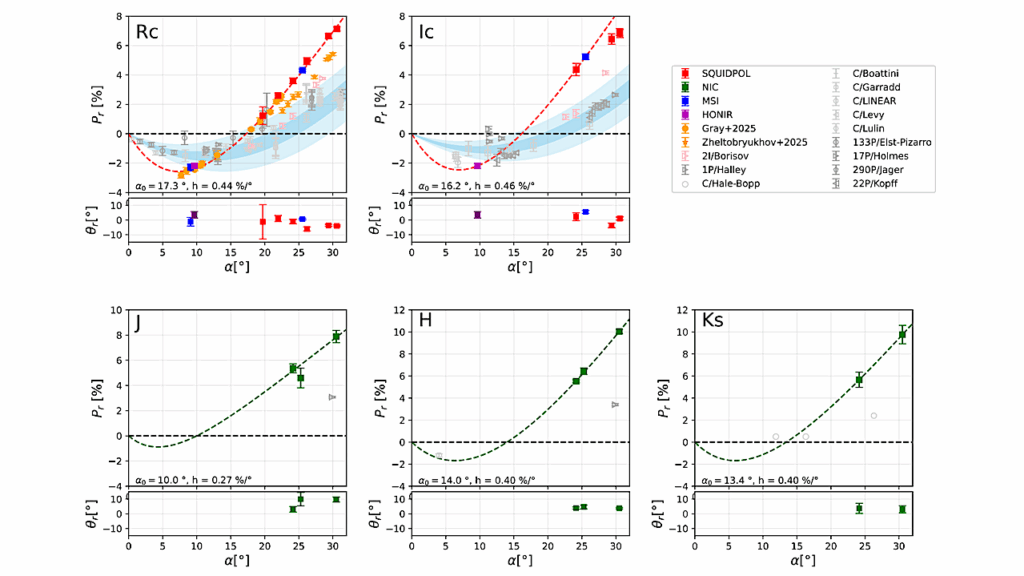The Cosmic Dust in Your Bones

Discovering too much money in your bank account may not be what you would call a “crisis,” but it would still be unexpected and you should figure out how it got there. Astronomers find themselves in a similar position when calculating the amount of dust galaxies should have; there is more dust than expected, and they don’t know where it’s coming from.
This matters because cosmic dust is essential to the function of the universe: it shelters forming stars, becomes part of planets, and can contain the organic compounds that lead to life as we know it. Dust led to us.
“What we refer to as the ‘dust budget crisis’ is the major problem in astronomy of not being able to account for all the dust that’s observed in galaxies, both in the nearby and distant, early universe,” says Ryan Lau of the Japan Aerospace Exploration Agency. Lau is leading a Director’s Discretionary Early Release Science Program with NASA’s upcoming James Webb Space Telescope to study dust-producing Wolf-Rayet binary stars.
Wolf-Rayet stars are very hot and very bright. There is evidence that Wolf-Rayet stars, through interactions with a companion star, produce large amounts of dust in a distinctive pinwheel pattern as the two stars orbit each other and their stellar winds collide. It is possible that these binary-star systems account for a large percentage of a galaxy’s “dust budget.” However, the intense luminosity and heat coming from the Wolf-Rayet stars has made it difficult to study the faint, more diffuse dust of these systems. This is where Webb comes in.
“The mid-infrared light that Webb can detect is exactly the wavelength of light we want to look at to study the dust and its chemical composition,” Lau explains. Infrared wavelengths are longer than the wavelengths of visible light, and so can slide between dust grains to reach the telescope, rather than getting caught up bouncing around in the dust cloud. Webb will detect this light and allow astronomers to read the information it carries, including the signature of chemicals in the dusty environment, some of which may be the same chemicals that form the building blocks of life on Earth.
“Webb has an unprecedented combination of spatial resolution and sensitivity in mid-infrared wavelengths that is really what enables us to conduct these interesting observations,” Lau says. “We can achieve the spatial resolution from ground-based telescopes, but lack the sensitivity that Webb can achieve from its observing location in space, without the interference of Earth’s atmosphere. Conversely, with previous infrared space-based telescopes like NASA’s Spitzer mission, we could achieve the sensitivity but lacked the spatial resolution.”
Targeting Two Dust Factories
Lau and the Director’s Discretionary-Early Release Science (DD-ERS) team will use Webb to study two Wolf-Rayet binary systems, using the telescope’s Mid-Infrared Instrument (MIRI) and Near Infrared Imager and Slitless Spectrograph (NIRISS). The WR140 binary system has been studied extensively in many wavelengths of light and so will provide a good baseline for gauging Webb’s best observing modes for this kind of cosmic subject. Another Wolf-Rayet binary, WR137, will experience its stars’ closest approach to each other–when the most dust is thought to be produced–early in Webb’s mission when the DD-ERS program observations are scheduled.
Beyond new discoveries about the formation and chemical composition of dust, the DD-ERS program also will be among the first opportunities astronomers have to test out best practices for Webb’s instruments and processing the data it delivers.
“This DD-ERS program will look at the best ways to maximize Webb’s dynamic range–the difference between the brightest and faintest objects it observes–and that will be useful to the astronomy community in many ways in the future; for example, in studying the dusty disk surrounding the bright center of an active galaxy, or finding a planet orbiting a bright star,” says Mansi Kasliwal, another astronomer on the DD-ERS team. Kasliwal led the laboratory at the California Institute of Technology where Lau performed his post-doctoral research on Wolf-Rayet binaries and developed the proposal for the DD-ERS program.
Both Lau and Kasliwal agree that while the open question of how cosmic dust is created and disseminated throughout the universe is a fascinating one, it is really a stepping stone toward answering one of the biggest questions ever posed: How did we get here? As far as we know, Earth is an island of life in the universe, and in seeking to understand something as seemingly remote as cosmic dust, Lau says that we are ultimately seeking to understand ourselves. “Understanding the formation of dust is critical for us to trace our own cosmic origins,” Lau says. “Webb is one of the most powerful scientific tools ever built in the quest to find answers to these fundamental questions.”
The James Webb Space Telescope will be the world’s premier space science observatory when it launches in 2021. Webb will solve mysteries in our solar system, look beyond to distant worlds around other stars, and probe the mysterious structures and origins of our universe and our place in it. Webb is an international program led by NASA with its partners, ESA (European Space Agency) and the Canadian Space Agency.
For more information, visit www.nasa.gov/webb
Astrobiology, Astrochemistry








